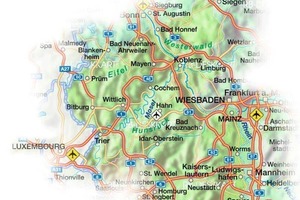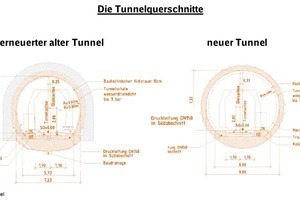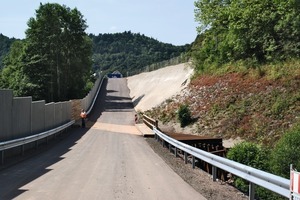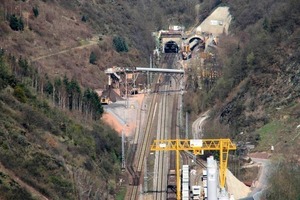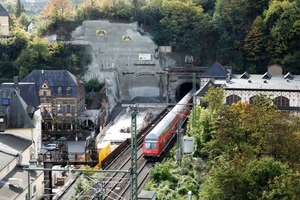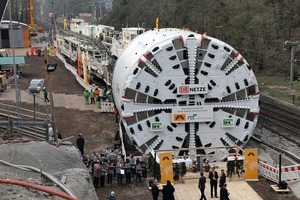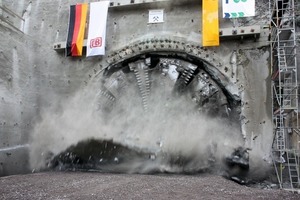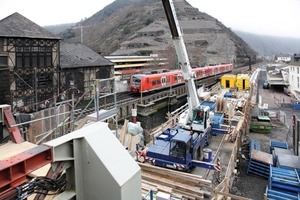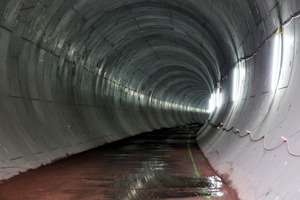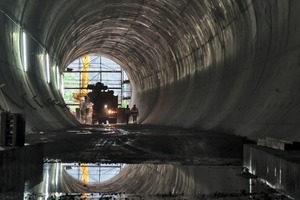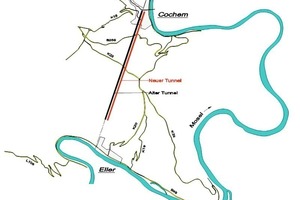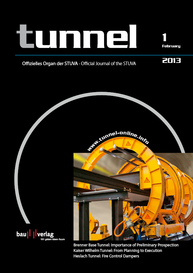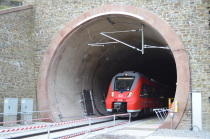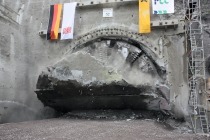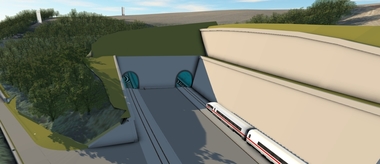Kaiser Wilhelm Tunnel: From Planning to Execution
The Kaiser Wilhelm Tunnel (KWT), operating with twin tracks, is located on the Moselle 321 corridor on line 3010 Coblenz – Perl in the Coblenz – Moselle – (Ehrang) between Cochem Station (Bf) and the Ediger-Eller part of the station (Bft) that belongs to it – between route km 48.4+18 and 52.6+23. It is 4,205 m long and was Germany’s longest railway tunnel until the new Hanover-Würzburg route was constructed in the early 1980s.
The KWT is currently being developed into a modern tunnel corresponding with the latest safety requirements. This report examines all project phases whilst concentrating on the extensive history relating to developing the project.
Historical Background
The rail line between Coblenz and Trier was established during the 1870s. A part of this scheme was the production of a tunnel between the towns of Ediger-Eller and Cochem, which was to pass directly underneath the “Krampen” mountain range. On May 15, 1875 driving activities on the tunnel commenced from the south from Ediger-Eller; work began from Cochem in the north on August 10. Construction was carried out by driving a base heading, full excavation followed by timbering and a masonry lining of the inner shell using small-format grauwacke and slate rock. The twin-track Kaiser Wilhelm Tunnel (KWT) opened in 1979 after only 4 years of construction. The tunnel is covered by some 250 m of rock and overcomes a difference in altitude of 14 m from portal to portal. Safety bays are provided every 15 to 18 m, the centre distance amounts to 3.50 m. At the time, the construction costs amounted to 8.8 million Reichsmark. Apart from several renovation schemes applying to the vault, the base and the recesses, electrification of the Moselle route in 1974 must be mentioned.
As part of this electrification process, the tunnel floor was lowered by an average of 40 cm from 1972 till 1974 in order to obtain the necessary height for installing the current collector. Reinforced concrete aprons were used to anchor the foundations for the abutment.
Classification in the strategic Plan
The route 3010 Coblenz Hbf – Perl is designed for mainline and regional traffic. It is of great significance for passenger traffic with connections to Coblenz and Trier, It also serves as a main transit line for goods traffic towards Luxembourg and is thus of enormous importance as part of the Deutsche Bahn route network. Currently around 170 trains pass through the tunnel on a daily basis at speeds averaging 90 to 120 km/h.
It must be said however that after more than 130 years of service at full capacity the inner shell of the Kaiser Wilhelm Tunnel has not remained unscathed and continuing to operate the tunnel after only resorting to temporary modifications was no longer acceptable. Furthermore the safety requirements posed on a tunnel of this length could no longer be complied with. Thus it was imperative to completely renovate the Kaiser Wilhelm Tunnel in order to ensure that traffic on this route could flow safely and reliably in the future as well.
Renovating the twin-track tunnel while still operational would have had a massive effect on traffic without improving the safety level. Instead it was necessary to considerably improve the existing tunnel structure and build a new single-track tunnel bore as well as renewing the existing tunnel to produce a further single-track bore.
This meant that the prerequisites that the DB Netz AG had to fulfil on the basis of the EBA Guideline 01/97 “Requirements on Fire and Catastrophe Protection for the Construction and Operation of Railway Tunnels” from July 1, 1997 with amendments up to November 1, 2001 were met relating to all planning, constructional and operational general conditions. The planning phase for the tunnel could start.
Pre-Planning
In 2001/2002 a pre-planning phase was worked out for the scheduled construction of the new tunnel and the renovation of the existing one. Its outcome was duly confirmed by the responsible Deutsche Bahn (DB) offices and subsequently taken as the basis for further planning. During the pre-planning stage a number of variants were examined and included in the further planning activities, initially the regional planning procedure, particularly with respect to:
the location of the new tunnel (to the west or east of the existing one),
the tunnel excavation concept (with tunnel boring machines or drill+blast) and
the waste disposal concept (removal, storage, recycling).
Regional Planning Compliance
According to § 1 Paragraph 9 of the Regional Planning Act a regional planning procedure must be undertaken for the new construction and altering of routes of railways providing it is of relevance for regional planning and at supraregional level. On this basis the Struktur- und Genehmigungsdirektion Nord (SGD Nord) in Coblenz – the supreme regional planning authority in Rhineland-Palatinate – undertook a regional planning procedure in winter 2002/2003. At the time, the possible variants, the building of a new tunnel bore either to the east or to the west of the existing one, were subjected to extensive scrutiny. The outcome of the overall appraisal foresaw the redevelopment of the old KWT and the production of a new second tunnel bore to the east of the existing one (regional planning decision reached on February 28, 2003, FN: 41-433-04-1).
Approval Planning
Based on the regional planning ruling the documents were compiled for the approval planning and ultimately passed on to the Eisenbahn-Bundesamt (EBA) on December 8, 2003.
According to § 18 of the “General Railway Act” (AEG) new rail routes or railways can only be built, existing rail installations only changed, providing that the plan has been previously approved. The purpose of the plan approval proceedings is to ensure that all public-legal relationships between the project principle (DB Netz AG) and affected persons relating to the project are coordinated, regulated appropriately by law and the rail installations secured on a public-legal basis. The recognitions resulting from the prior regional planning procedure are taken into consideration.
The plan approval governs rail installations, which have to be built or altered as well as areas and facilities belonging to third parties, whose final or temporary utilisation (e.g. earth deposits, structural changes, etc.) is necessitated by the project.
According to § 18 (1) of the General Railway Law (AEG), plan approval embraces the environmental compatibility study carried out within the scope of the regional planning procedure, the presentation of the effects of the project on the environment and compensatory and alternative measures for unavoidable ecological effects caused by the project in individual cases in accordance with § 19 Paragraphs 1 and 2 of the Federal Nature Conservation Act (BNatSchG).
In conjunction with § 75 of the Federal Administrative Procedure Act (VwVfG) planning approval embraces all required public-legal permits, licenses, authorisations etc.
The plan approval decision (FN: 5112-03-0307-f) was taken by the EBA on June 30, 2006 following 2 sessions, at which all those involved put forward their viewpoints. It became legal in January 2007.
Design Planning
In order to lose as little time as possible the design planning was carried out by an external planning office on behalf of the DB parallel to the approval planning. Towards this end the pre-planning and approval planning stages were harmonised and the design planning supplemented by planning approval results. Internal scrutiny and the go-ahead for the design report were completed in 2007. In this way all internal and external prerequisites had been created enabling work on the KWT could be embarked on.
Award Planning
In spite of these prior conditions the first work at Ediger-Eller only got started in mid-2008. After all awards had to be planned satisfactorily, the project divided into construction phases and the tendering documents compiled.
Let us take avail of the opportunity to present the overall construction scheme.
Short Description of the Construction Scheme
The project “Building of the new Kaiser Wilhelm Tunnel and Renewal of the Old Tunnel” involves the following measures:
Separating the 2-way tracks into 2 individual, single-track operation tunnel bores, used by both passenger and goods trains, i.e.
Construction of a new single-track tunnel bore parallel to the existing tunnel,
Production of 8 connecting structures between the tunnel bores at maximum gaps of 400 m,
Installation of a new inner shell in the existing Kaiser Wilhelm Tunnel, while converting it to a single-track bore,
Adaptation and extension of the tunnel furnishings with the objective of complying with the EBA standard “Requirements on Fire and Catastrophe Protection for the Construction and Operation of Railway Tunnels” and the “Technical Specifications for Interoperability (TSI)”,
Production of a new 3-section bridge for the Trier-Coblenz line within the town of Cochem.
1st Construction Phase: Producing the New Kaiser Wilhelm Tunnel (NKWT)
During the 1st construction phase the Old Kaiser Wilhelm Tunnel (AKWT) is provided with an additional second bore running parallel to it, the New Kaiser Wilhelm Tunnel (NKWT). This new bore possesses a single track. In the process, the 8 connecting structures are built and linked up with the AKWT. Parallel to this the “Brückenstraße” rail overpass (EÜ) required for operating the NKWT is produced at the Cochem portal. It takes the form of a 10.40 m wide 3-section bridge each with clear widths of 10.80 m.
After completion of the tunnel roughwork the NKWT is to be provided with an accessible solid slab track right up to the evacuation areas. This can be used by road vehicles over its entire length thus making it easier for emergency services to arrive on the spot should there be an incident. Outside the solid slab track section, the superstructure possesses a ballast bed. Accordingly all safety technical systems needed are installed in keeping with TSI specifications. The NKWT can first be opened once all these conditions are complied with thus bringing the 1st construction phase to a conclusion. The AKWT will remain operational until the NKWT is opened.
2nd Construction Phase: Renovating the Old Kaiser Wilhelm Tunnel (AKWT)
After completing and commissioning the NKWT, the AKWT will be closed and redeveloped. The tunnel cross-section suffices to permit a new concrete bore to be installed without having to remove the existing masonry. Once the tracks, the ballast and the engineering technology have been removed, a new floor will be produced and then a vault installed. Supporting will be accomplished entirely with in situ concrete. After completion of the roughwork in the AKWT a solid slab track, the overhead wire, the safety equipment will all be installed to comply with the latest standard of engineering. During this construction phase the 8 connecting structures will be completed and integrated in the overall KWT project. After concluding the 2nd construction phase the entire tunnel will be approved after ensuring it complies with the latest state of the art.
Construction Cycle and Stage reached by Work
The entire project is split up into several contract sections (VP). The aim was to commission specialist firms directly to undertake the various assignments thus boosting medium-sized businesses. Table 1 displays the chronology involved.
As a result of the allocation of contract sections it was largely possible to adhere to the intended timetable. At present work on sections VP 1 to VP 4 has been completed. VP 5 is in progress and initial work has begun outside the NKWT on VP 6. The tendering stage for VP 7 has been concluded; the first half of 2013 will see work starting here on drawing up the execution planning. VP 8 and VP 9 are to be tackled in the course of 2013 and invitations for bids requested in 2014.
Special Features during the Construction Process
The NKWT is being driven from the south portal in the direction of Coblenz with a mechanised excavation and a single-shell support consisting of concrete precast parts. Both tunnel portals had to be secured by supporting structures. The tunnel boring machine with 10 m diameter was devised in such a way that it could pass through what was mainly hard rock as well as a soft ground section in the upper reaches of the town of Cochem with overburden of only 5 m in some cases. In addition to utmost precision in steering the machine, comprehensive monitoring was required. All the measured values had to be evaluated and checked at all times by corresponding experts. Furthermore in particularly endangered areas beneath a number of houses the ground between the boring machine and the lower edge of the foundations had to be stabilised using soil grouting. In this way settlements were confined to a minimum.
Initially the more than 900,000 t of excavated material removed was taken to a clay quarry in the Westerwald. For this purpose the drive depended directly on the trackbound transportation process. It was possible to remove around 1,000 m³ of waste daily via the busy route, representing an average rate of advance of 10 m/day. In order to compensate for delays caused by temporary standstills of the boring machine, it was possible to quickly reactivate a former dump at Wittlich with the help of the authorities and fill it with excavated material so that the drive could be speeded up by a third in some cases. The excavated material was removed and the segments carried to the site exclusively by means of trains, which considerably reduced noise and dust emissions.
The special features mentioned are merely capable of reflecting a part of the construction process. In the pre-cuts in particular unforeseen incidents tended to occur as there was no complete record available of what was located beneath the tracks, which led to additional activities, which had to be integrated within the construction process.
Summary
Thanks to the building of a new bore and renewal of the existing KWT the tunnel’s safety level can be upgraded and enabled to comply with current required standards. It must be said however that the concept of the new structure took a long time to bear fruit after being proposed in early 2001. Following a 7-year planning phase, a further 7 years of construction will be needed to complete the overall project thus making the KWT available in the long term for the Coblenz-Perl rail line as part of the trans-European network (TEN).

